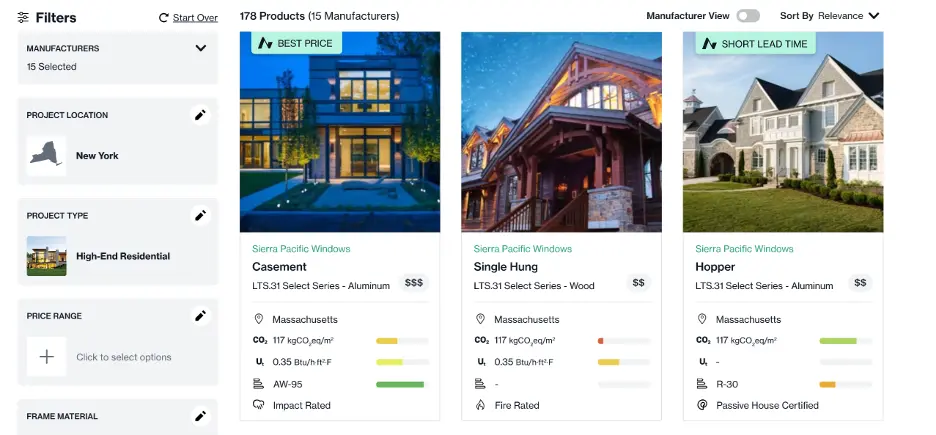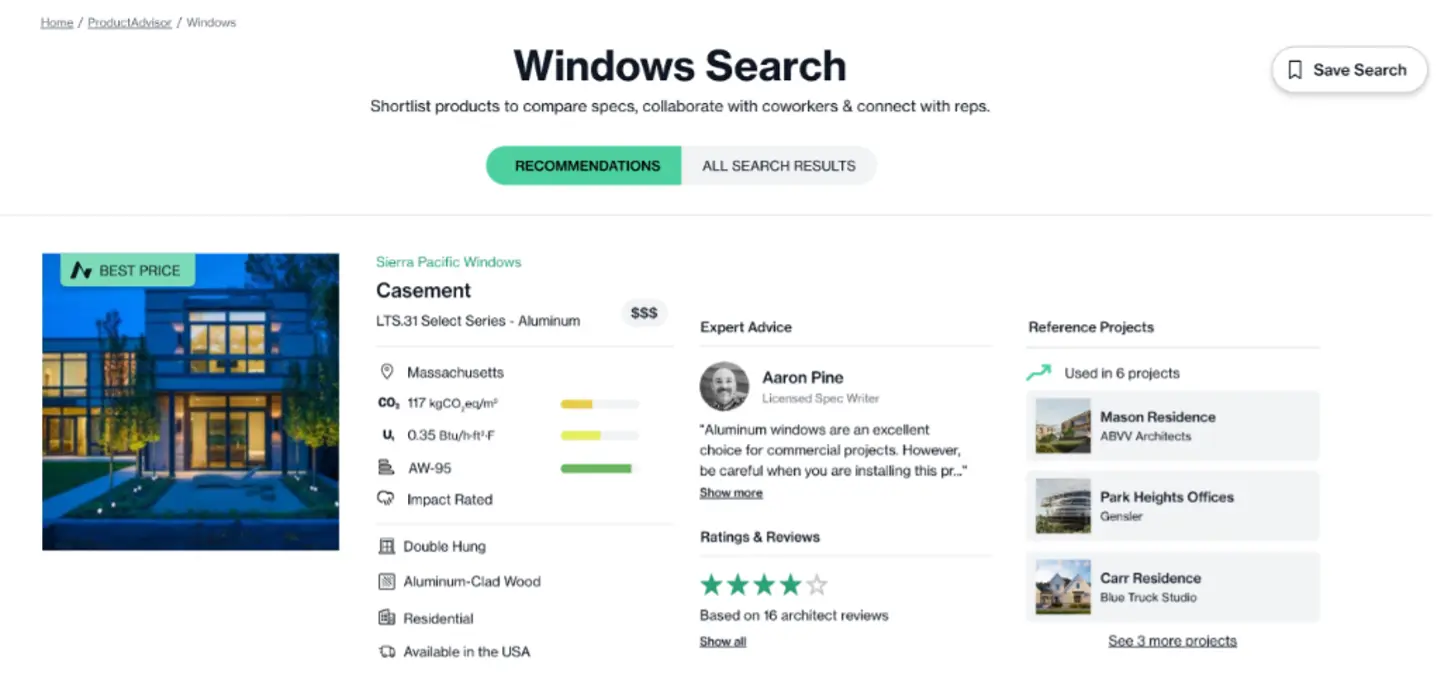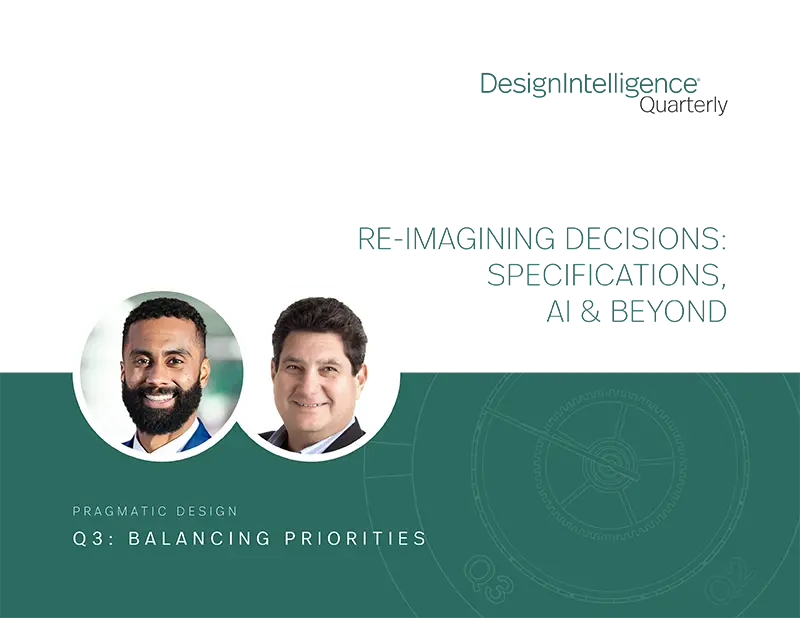Re-Imagining Decisions: Specifications, AI & Beyond
by Vardhan Mehta, AIA CSI
Architect & CEO, Acelab
& Dave Lemont
Former CEO, Revit & Executive Chairman, Acelab
September 13, 2023
Supercharging design value with intelligent specifications.
The Current Landscape
Architects as Influencers
While an architect’s standard of care can vary by project, certain roles remain constant: Consulting team leader, client domain expert, contractor guide and occupant advocate are some of the most common. In championing aesthetics, performance and sustainability, we strive to create buildings that are beautiful, functional and environmentally friendly — a better built environment for everyone. At the core of each of these functions is our ongoing need to make decisions. But how do we go about it? What are the priorities and processes to ensure good choices?
Decisions, Decisions
In all design phases, architects are charged with the evaluation and selection of the products, materials and systems that comprise our buildings. For thousands of years, we’ve used a largely intuitive and less-than-rigorous process to do it. Product selection — and their subsequent specification — is one of the most significant channels through which architects wield their influence and impact. Architects in the U.S. specify over $100 billion-worth of building products, materials and assemblies annually. Research shows that 73% of all products specified by architects end up in the project — a profound opportunity to maximize project success. But our specification workflows have only minimally evolved over the past three decades, while the number of building product solutions available in the market has quadrupled. We have witnessed the transformational power of technology on design practice with CAD and BIM, but the way we discover, organize and collaborate on product specifications is outdated and inefficient. It’s time for a revolution.
The Specifications Dilemma
While specifications shape the cost and performance of buildings, their workflow has been historically boring, tedious and time-consuming. From discovery to documentation, access to data is fragmented and siloed, making it difficult to find the information you need when you need it. It has also been difficult to collaborate on specifications, as different stakeholders often use different tools for research, spec creation, submittals and RFIs. This often leads to errors, delays and missed opportunities. Studies done in the U.K. suggest that 35 cents of every dollar spent on construction is wasted due to mistakes, errors and rework.
There is also an external challenge at play. As architects, we tend to rely on what we know. We’re taught in school that our experience, knowledge and intuition are of great value. But with the rapid innovation in the building products industry, it’s impossible to keep up with all the product options on the market. To put this in perspective, there are currently over 165,000 architectural buildings products being sold in the U.S. across 37,000+ manufacturers — and these numbers are only growing.
The next challenge is the generational gap. The majority of architecture students and graduates aspire to become design architects. Many lack interest in grasping the technical aspects of practice. This predicament is leading to a dire shortage of specifiers and spec writers to fully support the active project work at most architecture firms and a widening gap in the product selection discipline.
As a second-generation architect, Vardhan Mehta experienced this issue firsthand upon graduating from Pratt Institute in New York and entering practice. As a junior architect working on institutional projects for clients such as the State Department, MIT and Yale, Vardhan was constantly tasked with product research, comparison and reviewing specifications. At work, he felt like he was stuck in a time warp — his firm still relied on paper catalogs, brochures and sticky notes to specify.
Outside of work, he enjoyed access to digital tools that simplified access to the information required for daily life. He desired to grow his technical chops but lacked the right resources to do so. For instance, he realized that his firm constantly repeated product choices to stick to what they knew how to detail and visualize. Anecdotal evidence from architectural school friends confirmed that most firms select products that way. But it made him question his work. Was this the best way to find optimal product choices for projects? Are we performing our duty as experts to the client? Are we missing an opportunity to design beautiful, high-performance and sustainable projects because we lack knowledge or awareness of superior solutions — or have no way to manage the data? Sadly, the answers to these questions were yes.
Re-Imagining Specifications
Current market conditions have put enormous pressure on architects to find alternative products due to product substitutions and value-engineering activities. To cope, architects often recycle specs or copy-paste from previous projects, but many of those products are no longer available due to price, availability or being discontinued. This can lead to delays and increased projects costs.
Most of the architect’s time is spent on design documentation and coordination. In reality, product research can drastically affect achieving the project potential. Nine out of 10 small to mid-sized architecture firms in the U.S. currently lack a standard specification workflow or firmwide library. And after multiple revisions and price quotes, we have also seen product literature get lost across email threads, phone calls and sticky notes. All this has led to increasing errors and declining productivity. What can we do to right the product selection ship?
A New Toolset Emerges
Technology as Savior
Since the dawn of the digital revolution, we have witnessed its impact on our personal and business lives through intelligently harnessed data reuse and flow. But what about designers and builders? Perhaps our industry should explore IT’s potential to help architects find optimal products on projects.
A few decades ago, Dave Lemont, as the former CEO of Revit and general manager at Autodesk, helped spark the revolution to improve how buildings are designed and documented. Through software, he helped the industry understand the benefits and agility afforded by a 3D parametric model. After many years as a CEO of four other venture-capital-backed startup companies, Mr. Lemont has returned to his passion for the AEC industry as the executive chairman of Acelab to help move the industry forward toward another revolution: a radical rethinking of product research and specifications that is sorely needed.
Curation by impartial experts and large data models could address the present specification challenges. Curation would collect and organize information from multiple sources. This would be analyzed and presented in an easy-to-use format. Large data models could identify patterns and trends in product data. This information could help architects make better decisions about which products to specify. For example, a large data model could identify products that are most likely to meet performance requirements.
The combination of curation and large data models would make it possible for architects to systematically compare different products and optimize their specifications.

Current Product Research Workflows
- Per the American Institute of Architect’s data, 87% of U.S. architecture firms currently research and specify products thus:
- Data is saved on local servers, SharePoint and Google Drive — difficult to keep information up-to-date and organized.
- Architects get most of the information directly from manufacturers, who are, by definition, partial to their own products.
- Manufacturer websites are often difficult to navigate, unorganized or outdated.
- Legacy specification software only supports documentation, doesn’t address product discovery or collaboration with suppliers leading up to it (no decision trail or tree).
- Specification platforms often only list products from manufacturers that pay them, limiting the architect’s ability to comprehensively evaluate all available solutions.
What Architects Need
As an alternative to the disconnected current workflows described above, we believe the profession is ripe for a new toolset, one that enables and provides:
- On-demand collaboration with product reps and technical support teams, on the architect’s terms.
- The ability to optimize specifications based on factors such as cost, availability, performance, aesthetics and sustainability.
- Transparency and comprehensiveness while evaluating products.
- Impartial insights from practicing professionals such as spec writers, fellow architects and discipline experts.
Acelab: An Emerging Product Selection Platform Built for and by Architects
In response to this market need, over the past three years our team has collaborated with a group of architects to develop Acelab, a visual product selection platform that saves architects precious time on every project by allowing them to discover, organize and collaborate on product specs — all in one place.
Here is a sample screenshot of a typical project analysis for residential windows:
 Image courtesy of Acelab
Image courtesy of Acelab
Acelab’s platform is currently being used by over 9,000 architecture practices around the country, including well- known firms such as Gensler, SOM and Storybuilt as well as many small to midsize firms. Acelab’s product database has also grown to over 39,000 products across categories such as windows, doors, cladding, roofing and insulation. The current website includes:
- ProductAdvisor: Acelab’s proprietary search mechanism, ProductAdvisor, visually guides users through the building product ecosystem with the right questions to ask step-by-step.
- Project Workspace: Architects can organize their product shortlists in a personalized Project Workspace and share it with colleagues.
- Collaboration Portal: Acelab’s new, in-platform Collaboration Portal allows users to connect on demand with an Acelab product expert or a manufacturer’s specialist for critical product information, quotes and lead times.
Embracing the Transformative Potential of AI in Specification Workflows
Artificial intelligence (AI) and large language models (LLMs) are already beginning to transform how architects generate schematic designs. We believe these technologies have immense potential to streamline specifications. They are currently training an AI model capable of the following functions:
Recommending Products
These new technologies are training the AI model on a data set of building projects and their associated product specifications. The model will soon be able to recommend products to architects based on their project requirements, helping them optimize for factors such as price, availability, performance, sustainability and aesthetics.
Analyzing Trends
The AI model also analyzes product data trends. This information helps architects make better decisions about which products to specify. For example, the model identifies products becoming more or less popular. This information helps architects avoid specifying products that are becoming obsolete.
Generating Spec Sheets
Acelab’s AI also generates spec sheets for architects. This frees architects’ time so they can focus on other aspects of the design process. Spec sheets generated by AI and LLMs are more accurate and consistent than manually generated spec sheets.

Action Required
After thousands of years of winging it, it seems logical that the design and construction profession should join the digital age in how we process, evaluate and present product data. Our clients, collegues and constituents deserve it. Our buildings and planet do too.
Contact us at Acelab to continue the discussion.
David Lemont is an accomplished CEO, go-to-market strategist and adviser with over 30 years’ experience guiding high-tech startup companies. He has extensive experience in SaaS business applications with keen expertise in construction technology, having managed five companies to successful exits to high-tech leaders such as Autodesk, Trimble, HP, Oracle, etc. Best known for his role as CEO of Revit, the predominant way buildings are designed in 3D today, he joined Acelab with a vision to change the way architects automate product research and specification, passionate about how blending technology and design could empower architects to create better, more sustainable built environments for their communities.
Vardhan Mehta is the co-founder/CEO of Acelab and a former architect. Originally from central India, he graduated from Pratt Institute School of Architecture in 2018 with a B.Arch and worked as an architect at Weiss Manfredi, a leading New York architecture firm. He was awarded the coveted Presidential Merit Scholarship and gold medal at the Asian Design Awards, among other travel and research grants. He has also won three international design competitions in France, China and Berlin. In May 2021, Vardhan graduated from the Harvard University Graduate School of Design with a Master of Architecture degree in Urban Design. During his time at Harvard, he co-founded Acelab, a vertically integrated building products marketplace connecting architects and manufacturers, based on his firsthand experience in professional practice.

 Vardhan Mehta
Vardhan Mehta
 Dave Lemont
Dave Lemont
